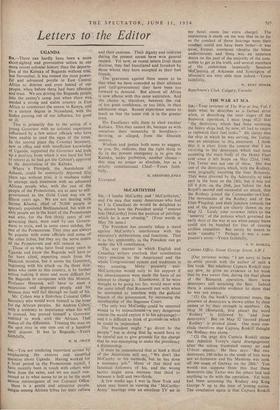THE WAR AT SEA SIR, —Your reviewer of The War at
Sea, Vol. 1 finds what he describes as a factual error when, in describing the later stages of the Bismarck operation, 1 state (page -412) that "the destroyers which had been screening the heavy ships had, by now, all had to return to replenish their fuel tanks." He claims that the ship in which he was serving, the Tartar, was an exception to this statement. 1 think that it is clear from the context that I am referring to the destroyers which had been screening the main body of the Home Fleet ever since it left Scapa on May 22nd, 1940. The Tartar was not one of these. She was one of the destroyers which, with the Rodney, were originally escorting the liner Britannic. They were diverted by the Admiralty to take part in the hunt on the 24th, but it was not till 6 p.m. on the 26th, just before the Ark Royal's second and successful air attack, that the Rodney joined the Commander-in-Chief. The movements of the Rodney and of the Fleet Flagship, and their junction towards the end of the pursuit are clearly shown on my Map 32. Lastly your reviewer refers to the ' temerity ' of the policies which governed the early days of the war at sea when enemy bases could not be bombed for fear of causing civilian casualties. But surely he meant to write ' timidity ' ? Perhaps it was a com- positor's error.—Yours faithfully,
S. W. ROSKILL
Cabinet Office, Great George Street, S.W.1
[Our reviewer writes: "I am sorry to have to cross swords with the author of such a fine book. But whafever Captain Roskill may say now, he gives no evidence in his book that he was aware that, during the final phase of the Bismarck operation, there were destroyers still screening the fleet. Indeed there is considerable evidence to show that he was not aware.
"(I) On the book's operational maps, the presence of destroyers is shown either by their names or by- their strength in numbers. On Map 30 (Bismarck, first phase) the word ' Rodney ' is followed by 'and four destroyers.' But on Map 32 (second phase) ' Rodney ' is printed alone. One must con- clude therefore that Captain. Roskill thought the Rodney was alone.
"(2) On page 416 Captain Roskill states that Admiral Tovey's rapid disengagement after ' the action frustrated enemy air and U-boat attacks. He then says: 'But two destroyers 100 miles to the south of him were not so fortunate and the Mashona was sunk off the coast of Galway on the 28th.' You would not suppose from this that these destroyers (the Tartar was the other) had had anything to do with the operation. Yet both had been screening the Rodney and King George V up to the time of joining action. The conclusion again is that Captain Roskill
was unaware of the part these ships had played.
"(3) Captain Roskill's letter above: He says that the destroyers he was referring to were those which had been screening the main body of the fleet from Scapa. But this is drawing a red herring; for, of the main body, only the King George V was now left. Captain Roskill's object in writing , the sentence for which I took him to task was to emphasise the handicap the C-in-C was under in having no destroyers. I submit that if he had known that the Tartar and Mashona were with the two battleships, he could not possibly have written this sentence.
"Yes, 'temerity' ought to have read 'timidity.' By the same token, 'Revenge' In the top centre of Map 32 ought to read 'Repulse.' "—Editor, Spectator.]



































 Previous page
Previous page